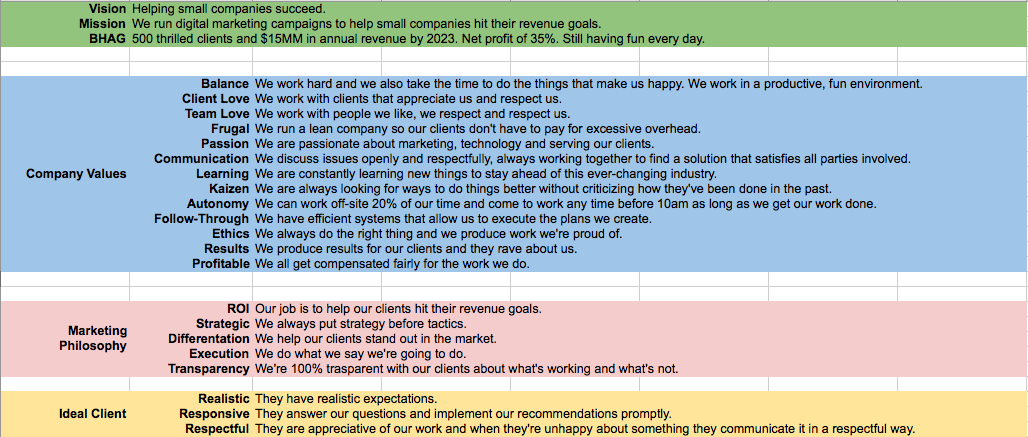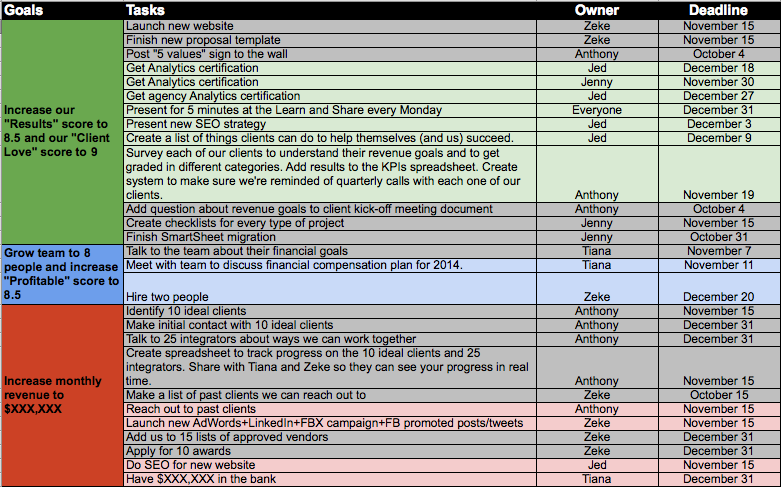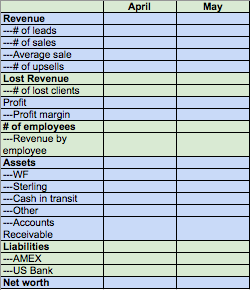The Problem
Think about that moment when you decided to start your own company. You figured that instead of working for someone else you could do the same work for yourself and starting a company seemed like a wonderful idea.
Soon enough, however, you realized that there’s a big difference between being a web designer and running a web design business, or between printing t-shirts and running an apparel company. You realized that there’s a huge difference between being a good technician and a great businessperson.
The first thing you found is that you had to start doing things you didn’t know how to do, such as selling, running profit & loss statements and managing people. And on top of all that, you had to find the time to do web design or print your t-shirts.
You arrived to the painful conclusion that just because you’re good at something it doesn’t mean you’ll be successful at running a business. But don’t worry. There’s hope.
The Solution
I believe that the key to success in business is being proactive. If you ask small business owners how they spend their days they’ll tell you they’re “taking care of problems” or “putting out fires.” Their schedules are dictated by problems that come up and they have very little control over how they spend their time.
Being proactive means setting a direction for your business and making sure that you’re always moving forward. The book The E-Myth puts it like this: “Entrepreneurs can work in their businesses or on their businesses. People who work in their businesses are technicians, but people who work on their businesses are true entrepreneurs.”
This means two things:
- Your job is to set the direction of your company, get the right people on the bus and make sure the bus moves forward toward its destination.
- You need to trust your team to put out the small fires. If you’re doing this yourself, then nobody is driving the bus.
My System
So, what does being proactive mean? What are the specifics? I’m glad you asked! I’ll show you the dashboard we’ve developed at Digital Aptitude and I’ll also include a link at the end of the post in case you want to download the template and use it for your company.
One-Page Business Plan
I believe that every business in the world needs a one-page business plan. Why? Because your employees won’t read a 50-page plan and because brevity is very powerful. Einstein said that if you can’t explain a concept in just a few words, you don’t understand it well enough. So, here’s our one-page business plan.

In the green section we have our vision, mission and big hairy audacious goal (BHAG). The vision is the impact you want to make on the world. The mission is how you are going to make it happen. And, the BHAG is where you get more specific (how many customers you want to have, how many stores will carry your products, etc).
In the blue section we have our values. Every quarter our team meets and each person rates how well we’re doing in each category. For example, one of our values is “Communication: We discuss issues openly and respectfully, always working together to find a solution that satisfies all parties involved.” I’ll rate that statement from 1 to 10 (one being “completely untrue” and 10 being “completely true”).
Then we discuss where our actions aren’t in line with our values and how we can improve that. For example, if the average score for the value “communication” is 5.8, we come up with specific things we can do the following quarter to get that score to an eight or nine.
You’re never going to get a 10 in every category and that’s OK. Doing this exercise every quarter allows you to make sure that your company’s values are being carried out, not just posted on a wall nobody sees.
It’s absolutely critical that your team is on board with your values. If you’re the only one believing in them and nobody else cares, you’re on the wrong track. When I assembled my team at the agency, we came up with our values together. I asked them, “What’s important to you? How would you describe the ideal workplace? What kind of relationship would you like to have with your co-workers and clients?”
Values are also extremely important when it comes to hiring and taking new clients. For example, one of our values is “Balance: We work hard and we also take the time to do the things that make us happy. We work in a productive, fun environment.” We’d never hire someone who is all about work and doesn’t like people around him or her having fun. Also, we’d never work with a client that doesn’t appreciate our work or expects us to wake up at 2am to make a change to their website.
But remember: values are only as good as how seriously you take them. If you post them on a wall and forget about them, nothing will change. But, if you go over them with your team every quarter and consider them when taking on a new client or employee, they’re extremely helpful.
In the pink section you’ll find our marketing philosophy. We approach marketing differently than most agencies and it’s important to me that every person in the agency can explain these five values to our clients. Every now and then we randomly ask someone on our team to list our five core values (and they better know them!).
And finally, you’ll find a description of our ideal client in the yellow box. This is because we believe that for a business to be successful, you have to be smart about who you work with.
Quarterly Goals
As I previously mentioned, our team meets every quarter. During these meetings we talk about the goals we had for our previous quarter and the goals we want to set for the following quarter. Once again, I believe that by involving my entire team in these conversations everybody’s buy-in is guaranteed, because it’s our ideas we’ll work on, not my ideas that I impose on everyone else. This does wonders for employee morale, by the way, because people like working in places where their ideas count and they have control over where the company goes.
Plus, when I started doing this I quickly realized that I had the best idea only 20% of the time. The rest of the time, someone else had a better suggestion on how to do something. This is a great exercise. That is, assuming that you care more about your company doing well than you being always right.
These are our quarterly goals.

In the first column we have the goals. Goals are the score, the end result. For this reason, they need to be measurable: dollars, number of customers, etc.
For each goal we have tasks. Tasks are the steps that need to take place for the goal to be reached. We mark all the completed tasks in grey so during our weekly meetings we know what’s been done so far and what still needs to be completed. Tasks need to start with verbs, such as “create a spreadsheet” or “call John.” And, tasks need to be under your control. Otherwise, they’re goals. For example, “close 10 sales” is a goal, whereas “call 100 prospects” is a task.
And finally, make sure that each task is assigned to one owner and has a deadline. Unless you know who’s supposed to do something and by when, you won’t be able to execute your plan successfully.
Key Performance Indicators (KPIs)
Your KPIs will be different from mine, because the way you measure how well your business does is different from how I measure mine. So, it’s important that you make a list of the most important metrics in your business and track them every single month. I’ve attached a screenshot of this spreadsheet so you can see what mine looks like. I also added charts for all these metrics because I’m very visual and understand charts much better than numbers in a spreadsheet.

People
And finally, the last tab in our dashboard is “People.” This is what it looks like:


Every time we hire someone we give them a list of 12 motivation factors and ask them to rank their top three. We do this because different people are motivated by different things and, as a manager, it’s very important knowing what moves your people. Here’s the list of motivation factors we use. When you ask people what motivates them, make sure to tell them that there aren’t any wrong answers and ask them to be honest because if you don’t know what they want you can’t give it to them.
- Money
- Interesting work
- Opportunity for advancement
- A team environment
- Job security
- Making a difference
- Personal growth
- Responsibility
- Flexible work environment
- Positive relationships
- Praise
We also have each person’s areas of responsibility, which is a short version of their job descriptions. And finally, we have a list of potential hires. Most people network to meet clients. I network to meet our future hires. I’m probably the pickiest person when it comes to hiring because I know that there isn’t anything more important for the success of our business than hiring the best people we can find.
Spreadsheet Download Link
I hope you found this article useful. You can download the spreadsheet from here: Sample Company Dashboard. Keep in mind that this is the dashboard I developed for Digital Aptitude and yours will be different, so play around with the template until you’re happy with it.

